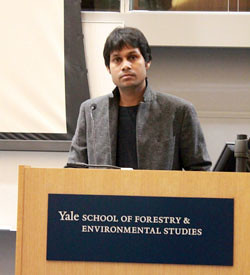Mark Turin reviews Highway, a unique and searing film that deserves a place in Nepal’s film history

SUMANA SERCHAN
The hall was packed with students, faculty, film buffs, and members of the public for the screening of the new wave Nepali feature film,
Highway . Although the movie has been screened in mainstream cinema in Nepal, this was only the third time it was being shown in the United States.
Last week, the Yale Himalaya Initiative and the Nepali Association of Yale Affiliates (
NAYA) hosted the
screening of
Highway and a discussion with the director, Deepak Rauniyar
(pic, right), in New Haven, Connecticut. The movie has generated considerable debate within Nepal and outside and having finally seen it, I can appreciate why. The film is as provocative, risky, and powerful as it is unusual, and it’s a credit to the creativity of the director, the producers, the brilliant actors, and crew that they pulled it off.
I have never seen a film like this, from Nepal or anywhere else, both in terms of its genre and the flexible elegance of its composition. The premise and conceit of the plot, a series of characters thrown together by chance on a long distance bus journey, battling through numerous strikes along the way, was convincing and poignant. As a social drama that illustrates how fate can shape lives in an instant and how fair-weather friendships can be made and broken in the space of a bus journey (note: the much-abused and put upon band are left to fend for themselves in the rain at the end of the film) is a powerful metaphor for the tensions that lie at the heart of contemporary Nepali society. These passing allegiances of expedience, between unlikely partners singularly committed to the common goal of reaching Kathmandu in a timely manner, works so well precisely because the narrative resists easy turns.
Highway is innovative in its use of handheld digital cameras, non-invasive audio, a jaundiced-feel yellow filter that creates a pervading sense of melancholy. It uses the risky but successful technique of permitting actors to improvise dialogue and thus escape from the overly hammed screeching monologues to camera that characterise poor Nepali films and TV dramas, not to mention the Bollywood ‘photocopies’ from which the director is so eager to escape.
Asked about audience reaction in Nepal, Rauniyar conceded that some loved it, while others hated it. The director remains more interested, however, in how viewers perceive and experience the movie than in its critical receipt, which has been arguably mixed.
“One complaint among Nepali cinema goers,” Rauniyar noted, “was that they found the film too short and were insufficiently entertained.” Since
Highway resists easy classification (it is certainly no Tourism Board-sponsored crowd pleaser, nor is it a DFID-funded documentary for social good) the job of marketing and distributing the film is not easy.
We can only hope that critical acclaim in Berlin and Montreal, not to mention simultaneous release in eight cinema halls in Australia, will in time help to give this unique and searing film the place that it deserves in Nepal’s film history. It is certainly at the top of my list of movies to screen in my Himalayan Film course at Yale next year.
www.highwayfilm.com
Mark Turin is an anthropologist and linguist who directs the Yale Himalaya Initiative and the Digital Himalaya Project.
See also:
"Why should a film be real?"
Director Deepak Rauniyar defends his unflinching portrait of contemporary Nepal in his new film, Highway
Highway
Deepak Rauniyar's new film, Highway is an experimental film for Nepal in many ways.